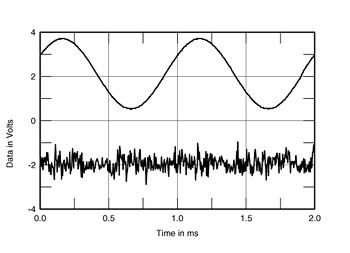| Columns Retired Columns & Blogs |
Sharp SM-SX100 digital integrated amplifier Measurements part 2
Even though the Sharp follows its output stage with passive low-pass filtering, the aggressive noiseshaping used in the Sharp's digital encoder results in this residual HF noise. There will also be a contribution from its switching output stage. The noise made it difficult to measure the SX-100's harmonic distortion. The bottom trace in fig.4, for example, shows the distortion residual on a 1kHz tone (top trace): it is random HF noise. Using an additional 6th-order passive filter (supplied by Sharp) on the amplifier's output, however, gave the trace shown in fig.5. What distortion the amplifier produces in the midrange and at low levels is almost pure third harmonic—around 0.05-0.2%, depending on frequency, load, and output setting—which will be subjectively innocuous.

Fig.4 Sharp SM-SX100, 1kHz waveform at 2W into 4 ohms (top), distortion and noise waveform with fundamental notched out (bottom, not to scale).

Fig.5 Sharp SM-SX100 with accessory passive low-pass filter, 1kHz waveform at 2W into 4 ohms (top), distortion and noise waveform with fundamental notched out (bottom, not to scale).
At low frequencies and very high levels (fig.6), the second and fourth harmonics make an appearance, but still at low levels. And even just below clipping with the punishing combination of equal 19kHz and 20kHz tones, intermodulation distortion was well below -70dB (fig.7).

Fig.6 Sharp SM-SX100, 8 ohm output, spectrum of 50Hz sinewave, DC-1kHz, at 105W into 4 ohms (linear frequency scale).

Fig.7 Sharp SM-SX100, 8 ohm output, HF intermodulation spectrum, DC-22kHz, 19+20kHz at 50W into 4 ohms (linear frequency scale).
- Log in or register to post comments




































